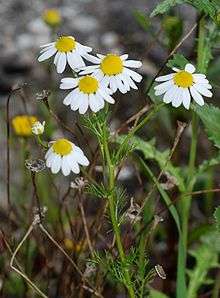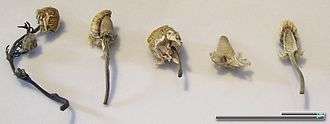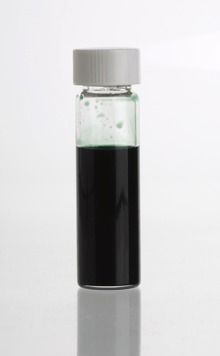Matricaria chamomilla
| Matricaria chamomilla | |
|---|---|
 | |
| Scientific classification | |
| Kingdom: | Plantae |
| (unranked): | Angiosperms |
| (unranked): | Eudicots |
| (unranked): | Asterids |
| Order: | Asterales |
| Family: | Asteraceae |
| Genus: | Matricaria |
| Species: | M. chamomilla |
| Binomial name | |
| Matricaria chamomilla L. | |
| Synonyms | |
|
Chamomilla chamomilla (L.) Rydb. | |
Matricaria chamomilla (synonym: Matricaria recutita), commonly known as chamomile (also spelled camomile), Italian camomilla, German chamomile,[3] Hungarian chamomile (kamilla), wild chamomile or scented mayweed,[4][5] is an annual plant of the composite family Asteraceae. M. chamomilla is the most popular source of the herbal product chamomile, although other species are also used as chamomile.[3]
Etymology
The word chamomile comes from the Greek χαμαίμηλον (chamaimēlon) meaning "earth-apple",[6] which is derived from χαμαί (chamai) meaning "on the ground"[7] and μήλον (mēlon) meaning "apple".[8] It is so called because of the apple-like scent of the plant.
Chamomile blue refers to chamazulene, the purified, deep-blue essential oil derived using steam distillation, rather than the plant itself.
Description
M. chamomilla has a branched, erect and smooth stem, which grows to a height of 15–60 cm (6–23.5 in). The long and narrow leaves are bipinnate or tripinnate.

A. Yellow disc florets
B. White ray florets
The flowers are borne in paniculate flower heads (capitula). The white ray florets are furnished with a ligule, while the disc florets are yellow. The hollow receptacle is swollen and lacks scales. This property distinguishes German chamomile from corn chamomile (Anthemis arvensis), which has a receptacle with scales. The flowers bloom in early to midsummer, and have a strong, aromatic smell.
Distribution
M. chamomilla can be found near populated areas all over Europe and temperate Asia, and it has been widely introduced in temperate North America and Australia. It often grows near roads, around landfills, and in cultivated fields as a weed, because the seeds require open soil to survive.
Uses
Herbalism


German chamomile is used in herbal medicine for a sore stomach, irritable bowel syndrome, and as a gentle sleep aid.[9] It is also used as a mild laxative and is anti-inflammatory[10] and bactericidal.[11] It can be taken as an herbal tea, two teaspoons of dried flower per cup of tea, which should be steeped for 10 to 15 minutes while covered to avoid evaporation of the volatile oils. The marc should be pressed because of the formation of a new active principle inside the cells, which can then be released by rupturing the cell walls, though this substance only forms very close to boiling point. For a sore stomach, some recommend taking a cup every morning without food for two to three months.[12]
One of the active ingredients of its essential oil is the terpene bisabolol.[13] Other active ingredients include farnesene, chamazulene, flavonoids (including apigenin, quercetin, patuletin and luteolin) and coumarin.[13]
Dried chamomile has a reputation (among herbalists) for being incorrectly prepared because it is dried at a temperature above the boiling point of the volatile components of the plant.
Potential pharmacology
A 2006 review of the medical literature reported a number of beneficial effects for chamomile in in vitro and animal tests, but added more human clinical trials are needed before any firm conclusions can be drawn. Research with animals suggests antispasmodic, anxiolytic, anti-inflammatory and some antimutagenic and cholesterol-lowering effects for chamomile.[14]
Possible side effects
Chamomile, a relative of ragweed, can cause allergy symptoms and can cross-react with ragweed pollen in individuals with ragweed allergies. It also contains coumarin, so care should be taken to avoid potential drug interactions, e.g. with blood thinners.
While extremely rare, very large doses of chamomile may cause nausea and vomiting. Even more rarely, rashes may occur.[15] Type-IV allergic reactions (i.e. contact dermatitis) are common and one case of severe Type-I reaction (i.e. anaphylaxis) has been reported in a 38-year-old man who drank chamomile tea.[16]
Cultivation
Soil type: German chamomile will tolerate many soils, but prefers a sandy, well-drained soil with a pH of 7.0-7.5 and full sun.
Cultivation: In gardens, plants should be spaced 15–30 cm (6–12 in) apart. Chamomile does not require large amounts of fertilizer, but depending on soil tests, small amounts of nitrogen, phosphorus, and potassium should be applied before planting.[17]
The amounts of major nutrients that German chamomile needs for growing and reproduction are:
- P = phosphorus 2,000 ppm (0.2%)
- K = potassium 10,000 ppm (1%)
- N = nitrogen 8,500 ppm (0.85%)
- S = sulfur 1,000 ppm (0.1%)
- Ca = calcium 5,000 ppm (0.5%)
- Mg = magnesium 2,000 ppm (0.2%)
See also
References
- ↑ "Matricaria chamomilla". Natural Resources Conservation Service PLANTS Database. USDA. Retrieved 15 June 2008.
- ↑ "Matricaria recutita". Integrated Taxonomic Information System. Retrieved 15 June 2008.
- 1 2 "German Chamomile". University of Maryland Medical Center. 2011. Retrieved 14 December 2012.
- ↑ Fitter R, Fitter A, Blamey M. 1989. The wild flowers of Britain and Northern Europe. Collins
- ↑ Stace C. 1991. The New Flora of the British Isles. Cambridge University Press
- ↑ χαμαίμηλον, Henry George Liddell, Robert Scott, A Greek-English Lexicon, on Perseus
- ↑ χαμαί, Henry George Liddell, Robert Scott, A Greek-English Lexicon, on Perseus
- ↑ μήλον, Henry George Liddell, Robert Scott, A Greek-English Lexicon, on Perseus
- ↑ "Chamomile (Matricaria Recutita)". herbwisdom.com. Retrieved 15 October 2014.
- ↑ Bhaskaran, N; Shukla, S; Srivastava, JK; Gupta, S (December 2010). "Chamomile: an anti-inflammatory agent inhibits inducible nitric oxide synthase expression by blocking RelA/p65 activity". Int J Mol Med. 26 (6): 935–40.
- ↑ Tayel, AA; El-Tras, WF (2009). "Possibility of fighting food borne bacteria by egyptian folk medicinal herbs and spices extracts". J Egypt Public Health Assoc. 84 (1-2): 21–32.
- ↑ "Chamomile". Planet Botanic. Retrieved 12 February 2009.
- 1 2 McKay DL, Blumberg JB (2006). "A review of the bioactivity and potential health benefits of chamomile tea (Matricaria recutita L". Phytother Res. 20 (7): 519–530. doi:10.1002/ptr.1900. PMID 16628544.
- ↑ Mckay, Diane L.; Blumberg, JB (July 2006). "A review of the bioactivity and potential health benefits of chamomile tea (Matricaria recutita L.)". Phytother Res. 20 (7): 519–30. doi:10.1002/ptr.1900. PMID 16628544.
- ↑ Readers' Digest Association
- ↑ Andres, C; Chen, WC; Ollert, M; et al. (2009). "Anaphylactic reaction to camomile tea". Allergol Int. 58: 135–136. doi:10.2332/allergolint.c-08-63.
- ↑ http://www.omafra.gov.on.ca/english/crops/hort/herbs/chamom.htm
Further reading
- Graedon, Joe; Theresa Graedon (2001). The People's Pharmacy Guide to Home and Herbal Remedies. St. Martin's Griffin. p. 283. ISBN 978-0-312-26764-3.
- Reader's Digest Association (1999). The Healing Power of Vitamins, Minerals, and Herbs. Reader's Digest. p. 259. ISBN 978-0-7621-0132-0.
- Wang, Mei; Avula, Bharathi; Wang, Yan-Hong (1 June 2014). "An integrated approach utilising chemometrics and GC/MS for classification of chamomile flowers, essential oils and commercial products". Food Chemistry. 152: 391–398. doi:10.1016/j.foodchem.2013.11.118.
External links
| Wikimedia Commons has media related to Matricaria recutita. |
- Fair Trade Organic Chamomile Tea - Benefits of Chamomile
- Chamomile for IBD/Crohn's
- Herbal Supplements in Pregnancy - Lists active chemical components of chamomile
- Wild Chamomile in wildflowers of Israel
- Chamomile tea 'may ease diabetes - BBC
- Matricaria chamomilla (German chamomile). Monograph.